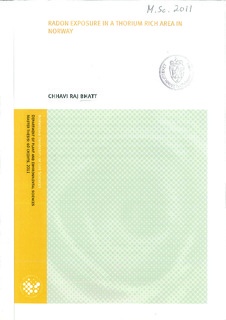| dc.description.abstract | This work was carried out in a thorium rich region, Fen Complex (FC), located in Telemark County, Norway. The area has been well recongised as a high natural radiation area in Norway due to the presence of considerable amount of thorium (along with relatively higher uranium) in the unique rocks of the area. In addition, the area also includes the sites, where iron and niobium mining was carried out during the past centuries. OBJECTIVES: The objectives were to measure outdoor radon and thoron concentrations as well as gamma dose rates/doses, to estimate public annual effective doses from gamma, radon and thoron exposures in the five selected areas of the complex (Bollodalen, Fengruve, Gruvehaugen, Rullekoll and Søve). The risk of human cancers (Solid cancers, leukaemia and lung cancer) from the estimated doses were also evaluated. MATERIALS AND METHODS: The absorbed gamma dose rates in air were measured during different months (May 2008, September and November 2009 and June 2010) with automess. Absorbed gamma doses in air were also measured in the area during summer 2010 with thermo luminescent dosimeters (TLDs). In addition, simultaneous outdoor radon and thoron measurements were conducted in the different locations of the region during autumn 2009 and summer 2010 with radon-thoron discriminative detectors. All the measurements were performed at the distance of one meter above the ground level. The TLD gamma doses were read at Jožef Stefan Institute, Ljubljana, Slovenia, and radon and thoron concentrations were measured at National Institute of Radiological Sciences, Chiba, Japan. All the data were entered and analyzed using Windows Office EXCEL 2007 and Minitab 16. For all analyses, p-values <0.05 were considered statistically significant. Annual average effective doses were estimated by extrapolating the absorbed doses in air of the measured period (2 months) and using the conversion factor 0.7 Sv/Gy.
In case of radon and thoron doses, Equilibrium Equivalent Concentrations (EEC in Bq/m3) were calculated using equilibrium factors (F); 0.7 for radon, and 0.003 and 0.1 for thoron. The EECs and doses from radon isotopes were derived using the relationships between EECs and Working Levels as well as Working Level Months (WLMs) and equivalent doses; 1 Bq/m3 of EEC=0.27 mWL (for radon) and 3.64 mWL (for thoron), and conversions; 10 mSv/WLM for radon and 3.4 mSv/WLM
for thoron. The outdoor occupancy factor of 0.2 (=1752 hrs/yr) for gamma as well as radon and thoron doses were taken into account while estimating their respective doses. The gamma dose risks were estimated assuming the excess relative risks of solid and leukaemia mortality of 0.4/Sv and 4.0/Sv respectively. Similarly, mean excess relative risk for lung cancer from radon and thoron exposures were estimated using 0.26%/WLM. RESULTS: The dose rates were found to be varied in all the areas during the studied months; Bollodalen (1.62-4.47 µGy/h), Fengruve (0.77-4.06 µGy/h), Gruvehaugen (1.57-9.17 µGy/h), Rullekoll (0.48-5.53 µGy/h) and Søve (1.03-11.05 µGy/h). The mean annual effective doses due to gamma at different areas were ; Bollodalen (1.76 mSv), Fengruve (2.48 mSv), Gruvehaugen (2.02 mSv), Rullekoll (1.17 mSv) and Søve (0.36 mSv). The mean radon concentration of the FC region in autumn (4.5 Bq/m3) was significantly lower (p<0.05) than that in summer (56 Bq/m3). Based on the summer radon concentrations measured, ANOVA General Linear Model did not show any significant difference in radon concentration (p>0.05) of the FC areas. The mean thoron concentration of the region in autumn (691 Bq/m3) was significantly lower (p<0.05) than that in summer (1593 Bq/m3). The mean thoron concentration of the complex during the autumn ranged from 7 Bq/m3
to 1000 Bq/m3, and that in summer ranged from 91 Bq/m3 to 1786 Bq/m3. ANOVA General Linear Model showed statistically significant different thoron concentrations measured different areas (p<0.05). Søve area had a significantly lower (p<0.05) thoron concentration than the other areas. A moderate strong correlation also observed between radon and thoron measured in summer (r=0.697, p<0.05). The regression analyses of gamma dose and radon and thoron showed that gamma dose line is better fitted with the measured thoron concentration data (R2=40.7%, p<0.05) than that with radon concentration (R2=31.7%, p<0.05) data. The mean effective doses due to outdoor radon exposures at the FC areas were; Bollodalen (1.55 mSv), Fengruve (1.78 mSv), Gruvehaugen (1.22 mSv), Rullekoll (1.05 mSv), and Søve (0.6 mSv). Similarly, the mean effective doses due to outdoor thoron (with F 0.003) exposures at the FC areas were; Bollodalen (0.52 mSv), Fengruve (0.6 mSv), Gruvehaugen (0.7 mSv), Rullekoll (0.5 mSv), and Søve (0.03 mSv). The thoron doses were estimated
33 times greater with the larger Feq
value of 0.1 than that estimated with F
eq 0.003. The mean risks of solid cancers and leukaemia from gamma doses were estimated to be in the range of 0.0001-0.001 and 0.001-0.01 respectively. The excess relative risks of lung cancer from radon exposures ranged 0.0001-0.0004, and that from and thoron were 0.00002-0.0004 (F 0.003) and 0.0007-0.019 (F 0.01). CONCLUSIONS: The present study found that the FC region has high outdoor natual gamma dose rates (1.16-8.43 µGy/h) as well as radon (7-210 Bq/m3) and thoron (7-4996 Bq/m3) concentrations. All of these values are considerably higher than global and Norwegian average corressponding values. Radon and thoron showed significantly lower air concentrations in the autumn than that in the summer. The estimated range of mean annual effective doses due to the natural radiation in the FC areas were also found remarkebly high; gamma (0.36-2.48 mSv), radon (0.6-1.78 mSv) and thoron (0.03-0.7 mSv). The risk of leukaemia from gamma doses was estimated to be higher (0.001-0.01) than that of solid cancer (0.0001-0.001), and lung cancer (0.00002-0.0005) from radon isotopes.Therefore, on the basis of the findings from this study, it can be recommended that the high dose areas in the FC require interventions in order to minimize the likelihood of human stochastic effects by limiting public doses as low as resonably achievable. | no_NO |
